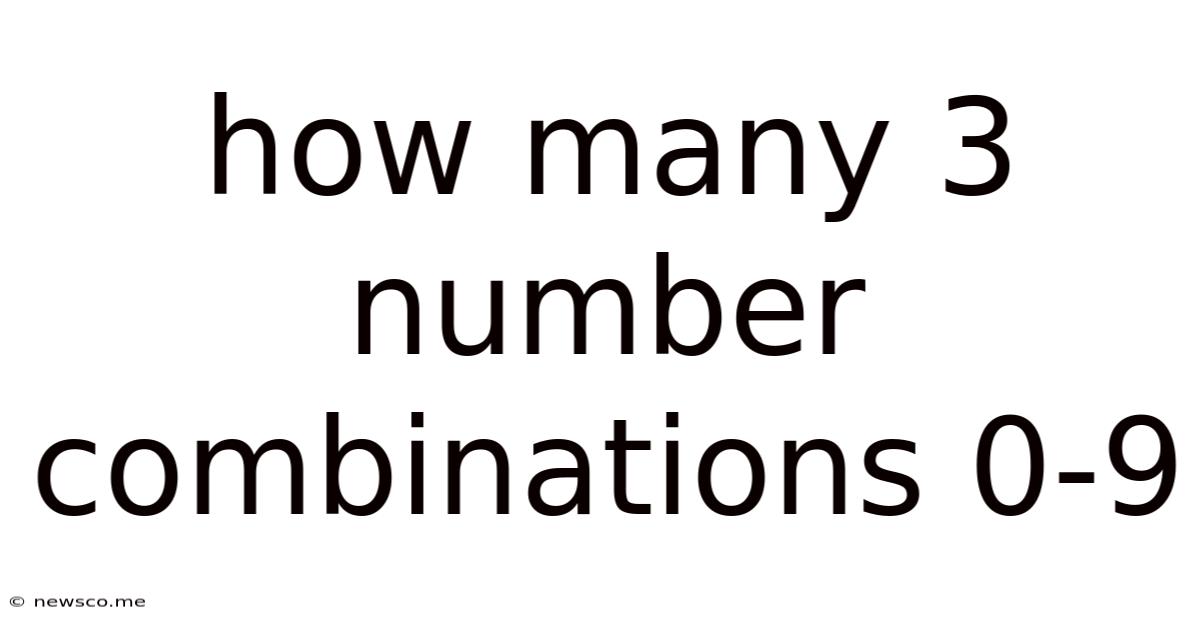How Many 3 Number Combinations 0-9
News Co
Mar 21, 2025 · 4 min read

Table of Contents
How Many 3-Number Combinations are There from 0-9? Unlocking the World of Combinatorics
The question, "How many 3-number combinations are there from 0-9?" might seem deceptively simple. However, it delves into the fascinating world of combinatorics, a branch of mathematics dealing with counting and arranging objects. The answer depends crucially on whether repetition is allowed and whether the order matters. Let's explore these scenarios in detail.
Understanding the Fundamentals: Permutations vs. Combinations
Before we dive into the calculations, it's crucial to understand the difference between permutations and combinations.
- Permutations: Permutations are arrangements where the order matters. For example, 123 is considered a different permutation than 321.
- Combinations: Combinations are selections where the order does not matter. 123 is considered the same combination as 321.
This distinction significantly impacts the number of possible outcomes.
Scenario 1: Permutations with Repetition Allowed
This is the simplest scenario. We have 10 choices (0-9) for each of the three digits. Since repetition is allowed, we can choose the same digit multiple times (e.g., 111, 222, etc.). The calculation is straightforward:
10 choices for the first digit × 10 choices for the second digit × 10 choices for the third digit = 10³ = 1000
Therefore, there are 1000 possible 3-number permutations with repetition allowed from 0-9.
Scenario 2: Permutations without Repetition
In this case, once we've chosen a digit, we can't use it again. Let's break down the calculation:
- First digit: We have 10 choices (0-9).
- Second digit: After choosing the first digit, we only have 9 choices left.
- Third digit: After choosing the first two digits, we have 8 choices remaining.
Therefore, the total number of permutations without repetition is:
10 × 9 × 8 = 720
There are 720 possible 3-number permutations without repetition from 0-9.
Scenario 3: Combinations with Repetition Allowed
This scenario is more complex. We're choosing 3 digits from 0-9, allowing repetition, but the order doesn't matter. This requires a different approach using the stars and bars method or combinations with repetitions formula.
The formula for combinations with repetitions is:
(n + k - 1)! / (k! * (n - 1)!)
Where:
- 'n' is the number of items to choose from (10 in our case, digits 0-9).
- 'k' is the number of items we're choosing (3 in our case).
Plugging in the values:
(10 + 3 - 1)! / (3! * (10 - 1)!) = 12! / (3! * 9!) = (12 × 11 × 10) / (3 × 2 × 1) = 220
There are 220 possible 3-number combinations with repetition allowed from 0-9.
Scenario 4: Combinations without Repetition
This scenario is the most restrictive. We're selecting 3 unique digits from 0-9, and the order doesn't matter. This utilizes the standard combination formula:
n! / (k! * (n - k)!)
Where:
- 'n' is the number of items to choose from (10).
- 'k' is the number of items we're choosing (3).
Plugging in the values:
10! / (3! * (10 - 3)!) = 10! / (3! * 7!) = (10 × 9 × 8) / (3 × 2 × 1) = 120
There are 120 possible 3-number combinations without repetition from 0-9.
A Practical Application: Lottery Numbers
Understanding these calculations is crucial in various real-world applications. One prime example is lottery number selection. If a lottery requires choosing 3 unique numbers from 0-9, the total number of possible combinations would be 120 (Scenario 4). Knowing this helps in understanding the odds of winning.
Expanding the Scope: Beyond Three Numbers
The principles discussed above can be extended to scenarios involving more than three numbers. The formulas for permutations and combinations will simply adjust based on the number of digits selected and whether repetition is allowed.
Tackling the Problem Programmatically
These calculations can also be approached programmatically using various programming languages like Python. Python offers efficient ways to generate permutations and combinations using libraries such as itertools. This allows for computationally exploring larger datasets and complex scenarios.
Here’s a basic Python example showcasing permutations with repetition:
import itertools
for combination in itertools.product(range(10), repeat=3):
print(combination)
This code snippet leverages itertools.product to generate all possible 3-number combinations with repetition from 0-9 (0 to 9 represented by range(10)).
Conclusion: Mastering the Art of Counting
The seemingly simple question of how many 3-number combinations exist from 0-9 reveals the richness and power of combinatorics. Understanding the distinctions between permutations and combinations, and whether repetition is allowed, is crucial for obtaining the correct answer. This knowledge has far-reaching applications in various fields, from probability and statistics to computer science and cryptography. The use of formulas, combined with programming techniques, offers efficient methods for exploring and solving more complex counting problems. So next time you encounter a counting problem, remember the power of permutations and combinations and break down the problem methodically. This knowledge not only empowers you to solve the problem at hand but also opens up a fascinating journey into the world of mathematics. Remember to always carefully consider whether order matters and whether repetition is allowed when tackling these types of problems. This careful consideration will lead you to the correct answer every time.
Latest Posts
Latest Posts
-
Find The Point On The Y Axis Which Is Equidistant From
May 09, 2025
-
Is 3 4 Bigger Than 7 8
May 09, 2025
-
Which Of These Is Not A Prime Number
May 09, 2025
-
What Is 30 Percent Off Of 80 Dollars
May 09, 2025
-
Are Alternate Exterior Angles Always Congruent
May 09, 2025
Related Post
Thank you for visiting our website which covers about How Many 3 Number Combinations 0-9 . We hope the information provided has been useful to you. Feel free to contact us if you have any questions or need further assistance. See you next time and don't miss to bookmark.